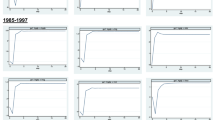Abstract
Many economists dismiss the role of positive supply shocks as a cause of Japan’s deflation. Indeed, they sometimes attribute the long delay in Japan’s recovery to the mistaken view that Japan’s deflation reflects an acceleration of technological progress. Whatever the current situation in Japan, however, economic history certainly suggests that technological progress can go hand in hand with general deflation. Conducting a VAR analysis using very detailed information about the components of Japan’s consumer price index, this paper finds that short-run shocks to Japan’s relative price structure persist in the long run. Given this finding, it is possible to conclude that such shocks are real in origin and reflect technological change. As no effort has yet been completed to show the full extent to which technological change is driving short-run relative price change in Japan compared with other factors, and the full extent to which relative price changes are driving aggregate price change compared with other factors, the policy implications of these findings are unclear. What is clear is that it is a mistake to dismiss out of hand the possibility that technological shocks are playing an important role among other forces in Japan’s current deflation.









Similar content being viewed by others
Notes
Hayami has never gone so far to maintain that all deflation is supply side in origin. In addition to supply–side shocks, he has also allowed that there is a “lack of demand” (Mainichi Shimbun, January 27, 2003) and that related to this “problems in the banking sector have impaired Japan’s credit creation mechanism” (Jiji Shimbun, November 23, 2002).
Seasonal effects have been muted by using two alternative methods: (1) year–over–year monthly changes; and (2) X–12 ARIMA with constant and level effects. Seasonal adjustment of Japan’s CPI is necessary because, unlike the United States, CPI seasonal adjustment is done by Japan’s statistical agencies only at the most aggregate level.
A money supply term is also included as part of this analysis.
Unit roots have been tested for using Augmented Dickey–Fuller and Ng–Perron. These tests reject the null unit–root hypothesis for all variables used in this analysis except average price change.
The analysis here has also been conducted with decisions on lag lengths and the inclusion or exclusion of linear and quadratic terms based on the Akaike Information Criterion. While many of the details of the analysis change dramatically (in particular the length of the lags), the conclusions of the analysis are in no significant way different from what is found when the Schwartz Information Criterion is used. This entire analysis has also been done on data seasonally adjusted by X–12–ARIMA without substantially altering the findings.
References
Balke NS, Wynne MA (2000) An equilibrium analysis of relative price changes and aggregate inflation. J Monet Econ 45:269–292
Ball L, Mankiw NG (1995) Relative-price changes as aggregate supply shocks. Q J Econ 110:161–193
Barsky R, Killian L (2001) Do we really know that oil caused the great stagflation? a monetary alternative, NBER Working Paper No. 8389
Basu S, Fernald J, Shapiro M (2001) Productivity growth in the 1990s: technology utililization or adjustment? Carnegie-Rochester Series on Public Policy 55:117–165
Bordo MD, Lane JL, Redish A (2004) Good versus bad inflation: lessons from the gold standard era, NBER Working Paper No 10329
Bryan M, Cecchetti S (1994) Measuring Core Inflation. In: Mankiw NG (ed) Monetary Policy, University of Chicago Press, Chicago
den Haan W (2000) The co-movement between output and prices. J Monet Econ 46:3–30
Hamilton JD (1994) Times series analysis, Princeton University Press, Princeton NJ
Hayami M (2001) Opening speech. Monet Econ Stud 19:9–11
Hayashi F, Prescott EC (2002) The 1990s in Japan: a lost decade. Rev Econ Dyn 5:206–235
Kawamoto T (2004) What do the purified solow residuals tell us about Japan’s lost decade? Institute of Monetary and Economic Studies Discussion Paper 2004-E-5
Klein LR (1962) An introduction to econometrics. Prentice-Hall, Englewood Cliffs NJ
Mio H, Higo M (1999) Underlying inflation and the distribution of price change: evidence from Japan’s trimmed-mean CPI. Monet Econ Stud 17:103–132
Nath HK (2004) Inflation and relative price stability: short-run vs. long-run. Econ Lett 82:363–369
Oliner S, Sichel D (2003) Where are we now and where are we going? J Policy Model 26:477–503
Organization for Economic Co-operation and Development (2004) Economic surveys: Japan, OECD, Paris
Parsley D (1996) Inflation and relative price variability in the short- and long-run: new evidence from the United States. J Money Credit Bank 28:323–341
Romer D (2001) Advanced macroeconomics. 2nd edn, McGraw-Hill, Boston
Saxonhouse G, Stern RM (2003) The bubble and the lost decade. World Econ 26:267–282
Shiratsuka S (1997) Inflation measures for monetary policy: measuring the underlying inflation trend and its implications for monetary policy implementation. Monet Econ Stud 15:1–26
Svensson L (2003) Escaping from the liquidity trap and deflation: the foolproof way and others. J Econ Perspect 17:145–166
Author information
Authors and Affiliations
Corresponding author
Additional information
Daehaeng Kim provided unusually helpful research assistance and advice with this research. Michael Bordo, provided excellent comments.
Rights and permissions
About this article
Cite this article
Saxonhouse, G. Good deflation/bad deflation and Japanese economic recovery. IEEP 2, 201–218 (2005). https://doi.org/10.1007/s10368-005-0035-z
Published:
Issue Date:
DOI: https://doi.org/10.1007/s10368-005-0035-z




